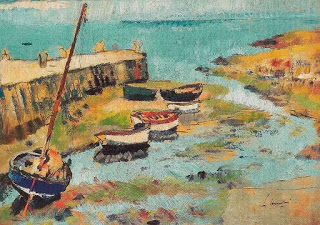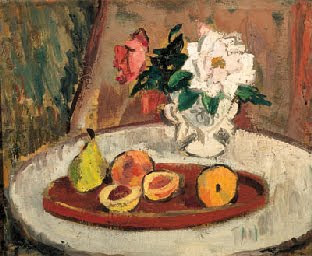The Mayo Clinic in Jacksonville, Florida, is a place of such contrasts. Dread and hope, anxiety and tranquility, fears and laughter. Yet it is often a vessel of transformations and healing alchemy.
There are sculptures gracing the lawns, fountains play in the different lakes, live oak trees shade camellias in bloom - all help calm and center the visitors to the Clinic.
There is, however, an even more beautiful gift of colour and light at the moment, in the Mayo building, en route to the hospital. It is a small exhibition of work by the Scottish Colourists, owned and lent by the major Mayo benefactors, Isabelle and Robert Davis.
I have always loved the bold, elegant work of the Scottish Colourists, a small group of artists who included Samuel John Peploe(1871-1935), John Duncan Fergusson(1874-1961), Francis Campbell BoileauCadell (1883-1937) and George Leslie Hunter (1877-1931). They achieved a wonderful fusion of French artistic influences that ranged from Manet to Cezanne and Gauguin, in composition, brushwork, colour and their choice of humble everyday objects that became monumental. Post Impressionist in their approach, they all worked together, often travelling to different locations to work as companions. Fergusson and Hunter were essentially self-taught, while the Academie Julian in Paris played an important role in their collective development, along with the artistic ferment of early 20th century France, where Matisse, Picasso or the Fauves were supplanting the Impressionists.
Still life - Peonies and Fruit, Samuel John Peploe
Whilst he painted many landscapes, Peploe loved to paint still lifes, such as this Peonies and Fruit, one of his many carefully arranged compositions. "There is so much in mere objects, flowers, leaves, jugs, what not - colours, forms, relations" he said. "I can never see mystery coming to an end."
Fergusson was also very much influenced by Manet and even Velazquez. He was a pivotal figure amongst the Scottish quartet of artists, and he in turn influenced other artists such as the young American artist, Anne Estelle Rice, (1877-1959), who had been trained at the Pennsylvania Academy of Fine Arts, before coming to Paris.
Anne Estelle Rice, drawing, John Duncan Fergusson
Fergusson painted some fine portraits of Rice; this is a drawing he did of her in preparation for a painting. She too produced some wonderfully strong and simple still life paintings, such as the one displayed at the Mayo, Still Life with Dahlias.
Anne Estelle Rice in Paris - Closerie des Lilas, 1907, oil on canvas, John Duncan Fergusson
Still Life, oil on canvas, Anne Estelle Rice
Her friend, Fergusson, produced a huge body of work: at a 1961 memorial exhibition, his artist friend, André Dunoyer de Segonzac, wrote, ""His art is a deep and pure expression of his immense love of life. Endowed with a rare plastic feeling, almost sculptural in its quality. he joined with it an exceptional sense of colour, outspoken, ringing colours, rich and splendid in their very substance." This late painting is a perfect example of his love of life.
The Red Sail, oil on canvas, John Duncan Fergusson
Frank "Bunty" Cadell studied in Paris and became noted for his portraits of glamorous women. He returned to Scotland, where he discovered the island of Iona, an important turning point in his development as an artist. He served in world War I, as did his fellow Scottish Colourists, and he reacted to the horrors of war with optimism and heightened joie de vivre, both of which were reflected in his subjects and the joy with which he painted them. He returned often, after the War, to his utopia, Iona, where he summered, alone or with Peploe in 1920. A fellow artist noted, "It seems to me more than ever clear that your forte lies in a gift of colour and light." The joyous mid-1920s painting above of Iona would bear out that statement.
Iona, oil on canvas, Frank "Bunty" Cadell
George Leslie Hunter moved from Scotland to California with his family as a young boy, but as an adult, he spent time in Scotland, France, Italy and America. He was recognised early on as a skilled draughtsman and drawing remained one of his great strengths. Like Cadell with Iona, Hunter found Largo, in Scotland, to be a place of great inspiration, as is shown in this painting. He was also noted for his treatment of light and sense of colour.
Lower Largo, George Leslie Hunter
The Davis collection of Scottish Colourists being shown at the Mayo is also rounded out beautifully by exquisite canvases by three artists who had links to the Scottish Colourists - Anne Estelle Rice, the American artist whom Fergusson both encouraged and celebrated in portraits.
Still life with fruit and flowers, Anne Estelle Rice (recently sold at Sotherbys)
Another Scottish artist, Anne Redpath (1895-1965), was a student of the Scottish Colourists while she was studying in Edinburgh. She later moved to the South of France with her husband where they became part of the Scottish Colourists circle. In her work, she was, to an extent, one of their heirs, being especially influenced by Peploe and Cadell.
Flowers on a White Table, Anne Redpath (Image courtesy of Portland Gallery)
Her celebration of familiar household objects in her still lifes and her use of colour harmonies of cool contrasting with warmer hues were hallmarks of her work. This wonderful flower study, Flowers on a white tablecloth, was in her collection at her death.
The last artist represented in the Mayo exhibition was a British artist, Robert Bevan (1865-1925). The link with the other Scottish artists was that he too studied at the Academie Julian in Paris. He also spent time in Brittany and was linked to the Pont-Aven school of artists who were experimenting with the use of colour and form. During his life, his work was considered controversial and too avant-garde, with one critic labelling his use of colour "garish". However, by the time he died in 1925, he was celebrated in art circles and hailed for his "modernist powers".
Near Applehayes, Robert Bevan
By the time I had finished savouring of the beautiful and interesting exhibition in the Mayo building, I had become sadly aware of how many preoccupied people had hastened past this gift of colour and light. All I can hope is that they will find a moment of peace and delight the next time they pass that way. They would be rewarded.











